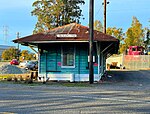Sonoma Valley Airport
Sonoma Valley Airport (FAA LID: 0Q3) is a public-use airstrip founded in 1946 by Wally Reichelt in Sonoma, California, United States. Its first California-certificated runway opened in August 1959. Located 4.14 nmi (7.67 km) south of central district of Sonoma (4.76 mi, 7.67 km) and 26.9 nmi (49.8 km) north of San Francisco (30.94 mi, 49.8 km), the airfield offers two asphalt runways, of which the 17/35 is restricted, needing prior permission to use. Open to public use for light aircraft, Sonoma Valley Airport does not allow ultralight and rotorcraft operations, except for MEDEVAC or law enforcement helicopters. There are no night operations. Flying hours begin at morning civil twilight and end at evening civil twilight. Fuel is self-serve. Among other fixed-wing aircraft, vintage planes can be seen on Sonoma Valley's apron, such as a fully restored, flying Curtiss P-40, a North American SNJ-4, three Boeing-Stearman PT-17 biplanes, a Globe Swift, a Cessna 195, a Douglas DC-3, a Dornier Do 27 or a Seabee amphibious. Others are being restored, like a Howard DGA-15. On the airfield are the Vintage Aircraft Company, air tour operator, and the North Bay Air Museum, a flying museum. Vintage Aircraft offers flights in restored WWII open cockpit Stearmans and AT6 Texan.
Excerpt from the Wikipedia article Sonoma Valley Airport (License: CC BY-SA 3.0, Authors).Sonoma Valley Airport
Flying Arrow Ranch Road,
Geographical coordinates (GPS) Address External links Nearby Places Show on map
Geographical coordinates (GPS)
| Latitude | Longitude |
|---|---|
| N 38.223277777778 ° | E -122.44777777778 ° |
Address
Sonoma Valley Airport
Flying Arrow Ranch Road
California, United States
Open on Google Maps




